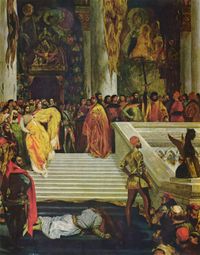
Marino Faliero
Encyclopedia

Doge of Venice
The Doge of Venice , often mistranslated Duke was the chief magistrate and leader of the Most Serene Republic of Venice for over a thousand years. Doges of Venice were elected for life by the city-state's aristocracy. Commonly the person selected as Doge was the shrewdest elder in the city...
, appointed on 11 September 1354. He was sometimes referred to simply as Marin Falier (Venetian
Venetian language
Venetian or Venetan is a Romance language spoken as a native language by over two million people, mostly in the Veneto region of Italy, where of five million inhabitants almost all can understand it. It is sometimes spoken and often well understood outside Veneto, in Trentino, Friuli, Venezia...
rather than standard Italian) or Falieri.
Biography
He attempted a coup d'etatCoup d'état
A coup d'état state, literally: strike/blow of state)—also known as a coup, putsch, and overthrow—is the sudden, extrajudicial deposition of a government, usually by a small group of the existing state establishment—typically the military—to replace the deposed government with another body; either...
in 1355, at the time being Doge himself, but with the intention of declaring himself Prince. This failed action is mostly attributed to a combination of a strong hatred for nobility and his senility (he was in his seventies at the time). He pleaded guilty to all charges and was beheaded and his body mutilated. Ten additional ringleaders were hanged on display from the Doge's Palace on St Mark's Square
Piazza San Marco
Piazza San Marco , is the principal public square of Venice, Italy, where it is generally known just as "the Piazza". All other urban spaces in the city are called "campi"...
.
He was condemned to damnatio memoriae
Damnatio memoriae
Damnatio memoriae is the Latin phrase literally meaning "condemnation of memory" in the sense of a judgment that a person must not be remembered. It was a form of dishonor that could be passed by the Roman Senate upon traitors or others who brought discredit to the Roman State...
, and as such his portrait displayed in the Sala del Maggior Consiglio (Hall of the Great Council) in the Doge's Palace was removed and the space painted over with a black shroud, which can still be seen in the hall today. An inscription reads: Hic est locus Marini Faletro decapitati pro criminibus ("This is the location of Marino Faliero, beheaded for his crimes").
The story of Marino Faliero's uprising was made into a drama
Drama
Drama is the specific mode of fiction represented in performance. The term comes from a Greek word meaning "action" , which is derived from "to do","to act" . The enactment of drama in theatre, performed by actors on a stage before an audience, presupposes collaborative modes of production and a...
by Lord Byron in 1820 and an opera
Marino Faliero (opera)
Marino Faliero is a tragedia lirica, or tragic opera, in three acts by Gaetano Donizetti. Giovanni Emanuele Bidéra wrote the Italian libretto, with revisions by Agostino Ruffini, after Casimir Delavigne's play...
by Gaetano Donizetti
Gaetano Donizetti
Domenico Gaetano Maria Donizetti was an Italian composer from Bergamo, Lombardy. His best-known works are the operas L'elisir d'amore , Lucia di Lammermoor , and Don Pasquale , all in Italian, and the French operas La favorite and La fille du régiment...
in 1835.

